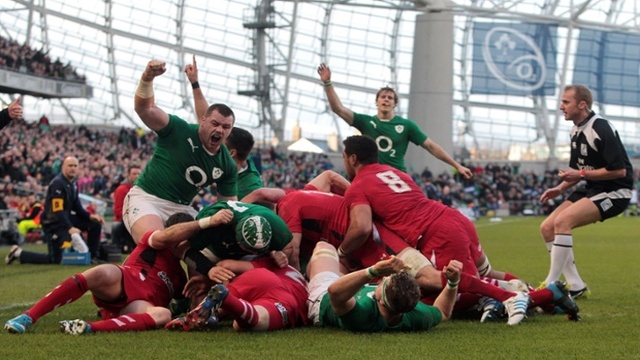Ireland’s tactical mugging of Wales was as beautiful as it was brutal. The kicking game was targeted and relentless. But it was all part of a grand build up. The rolling maul which created Ireland’s opening try was a masterpiece of misdirection. The Wales forwards were suckered into expecting a drive through the middle and suddenly Ireland had swept through the front of the lineout.
Join the world’s best coaches & players – Subscribe to The Rugby Site now
You could forgive Wales’s expectations. Up to that point Ireland had driven five of the nine lineouts that they had won. They had driven a five man lineout in a defensive position, and they had driven more traditional lineouts on the edge of the Wales 22.
But the brew had been fundamentally similar. Peter O’Mahony and Devin Toner always formed two points of the arrowhead. The third man varied. Chris Henry went in and secured the ball off the jumper, before retreating behind the bodies of the second wave. But the drive had been direct.
The lead-up to the opening try was a bombardment. Ireland had targeted Wales’s left wing and in the couple of minutes before the crucial score Jonny Sexton, Conor Murray and Rob Kearney sent seven consecutive kicks down that side. Wales must have felt they were being shelled. Eventually they broke and Priestland was forced to run the ball into touch by his line.
Rory Best then threw into the the lineout where Toner took the catch. O’Mahony and Mike Ross immediately went in on either side to seal off the maul and Henry smuggled the ball back. So far, so normal. Wales piled into the middle to stop the surge.
But as Toner had jumped, Jamie Heaslip had dropped out of the line. He now surged up the near side of the lineout with Best and Cian Healy in alongside. Henry tucked in behind and Paul O’Connell swept in from the back to add even more momentum.
Wales, fooled into thinking the attack was coming in one place, were literally powerless to stop the new wave. Ireland had set up a fake arrowhead in one place, and then pierced Wales’s defence with the real thing. People gurgle about dummy runs in the backs, but it its way, this fake rolling maul was every bit as pretty.
Joe Schmidt and John Plumtree deserve enormous credit for what they are doing with this Ireland side. They have identified the nation’s current strengths and they are playing to them. Ireland have a formidable driving pack, a very fine lineout, solid half backs and terrific catchers in the back three.
Watch Joe Schmidt’s ‘Attack Fundamentals’ coaching video now
Ireland saw how effectively Italy had played on Wales’s left wing the week before and they went after it. Early on Sexton hit a few poor kicks, but a plan doesn’t become unsound just because of poor execution. To his credit Sexton was not deterred by his early inaccuracy and Ireland just kept kicking away.
Ireland’s defence has also shifted in some ways. They are making far more low tackles than they did under the previous regime. They are stopping runners quickly and then attacking the breakdown when the opportunity arises.
Watch Richie McCaw’s ‘Tackle Techniques’ video now
The men in green really went after Wales’s front five. When they did run the ball, the first receiver nearly always ran at the Wales defence around the fringes. If it went a little wider then the centres would cut it back. Another part of setting up a successful rolling maul was to tire out Wales’s front five forwards in the tackle.
Ireland’s winning margin was not a fluke. They had identified Wales’s areas of weakness and pointed their own strengths at those weaknesses. The great Six Nations contest turned into a mismatch. Even as a neutral, you had to sit back and applaud.
Were you applauding the Irish game plan? Do you see Joe Schmidt’s men as the team to beat this year? Comments below…


